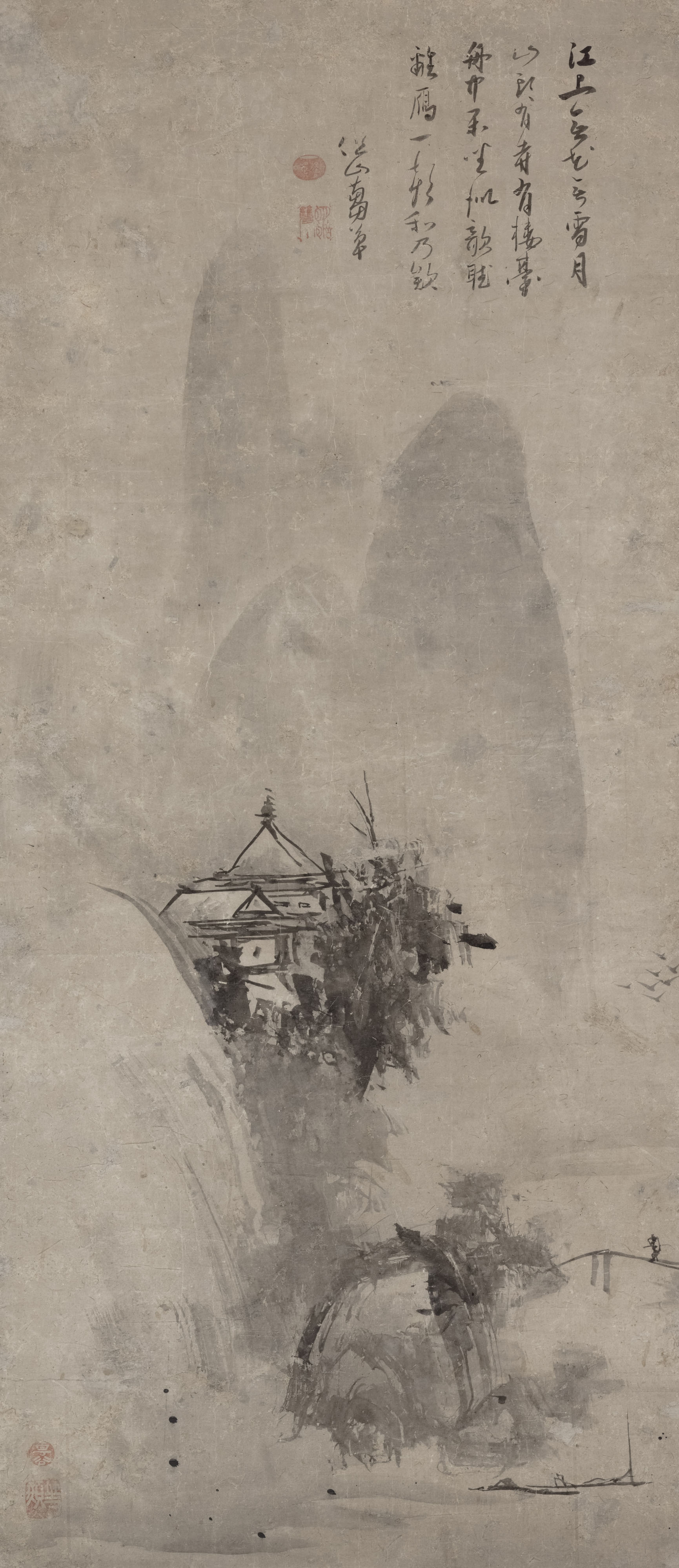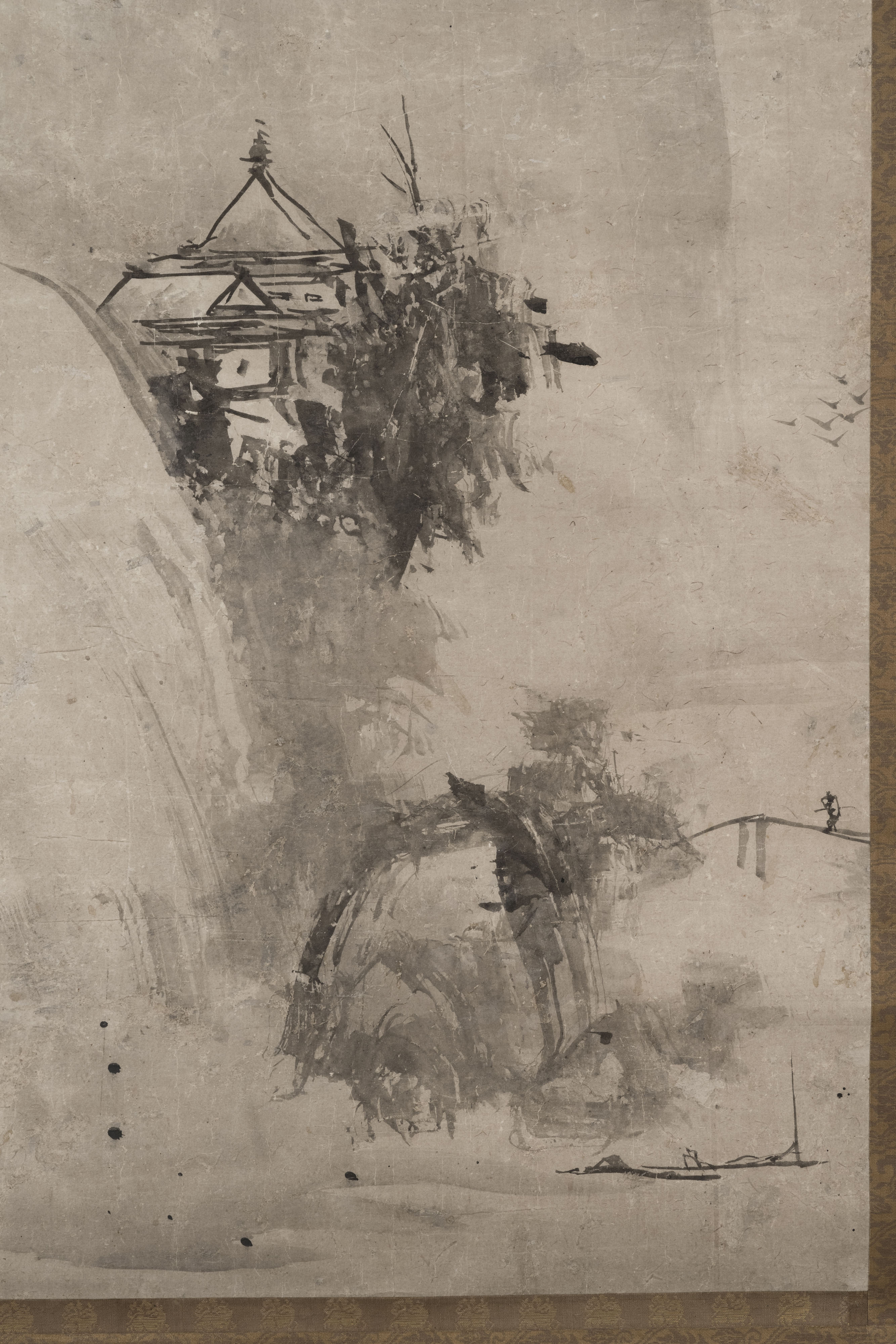
はつぼくさんすいず 溌墨山水図
不詳(安土桃山時代)
紙本墨画
一見何が描かれているのか分かりにくい水墨画です。よく見ると山や岩、樹木、楼閣、橋、舟、人、雁(かり)などが描かれた山水図と分かります。
この墨をはね散らすように画面上に溌(そそ)ぐ技法「溌墨(はつぼく)」は、中国南宋時代13世紀の画家・玉澗(ぎょくかん)が得意としたもので、日本では室町時代以降に流行し、雪舟も描きました。雪舟流を継いだ等顔ですが、本図では雪舟と同じモチーフを用いながら、独自の表現で描いています。岩の描写では、雪舟が筆を直線的に払うところを、等顔は曲線的に動かしています。岩や樹木には豪快に濃墨を、遠山や背景にはかすかに淡墨を用いるなど、剛と柔を兼ね備えている点が等顔の水墨画の魅力です。
右上の賛文は、京都・大徳寺153代の住持・澤庵宗彭(たくあんそうほう)の筆。「河の上には花や雪、月も見えないが、ここには寺も楼台もある。舟にしずかに座り詩歌を聴けば、離れゆく雁の声も舟歌に調和する」という意味の漢詩で、詩と絵の内容が一致しています。
雲谷等顔【うんこく とうがん】
生没年 1547-1618(天文16年~元和4年)
肥前国能古見(のごみ)(佐賀県鹿島市)の城主原直家の次男で、狩野永徳あるいは松栄に師事したと伝わります。毛利輝元から雪舟《山水長巻》(国宝・毛利博物館蔵)と雪舟の画室雲谷庵を授かり、雪舟流を継ぐ雲谷派を創設。萩を拠点に京都・大徳寺や東福寺の襖絵制作も行い、法眼(ほうげん)に叙任。連歌、茶の湯を嗜み、輝元に御伽衆(おとぎしゅう)として重用されました。
| 寸法 | 119.0×51.9cm |
|---|---|
| 形状 | 掛幅装 |

Splashed-ink Landscape
Ink on paper
It may be difficult to understand what is depicted in this ink painting at a glance.
If you examine the picture closely, you can see that it is a landscape depicting mountains, rocks, trees, a building, a bridge, a boat, a figure and wild geese.
This work uses the hatsuboku (splashed ink) technique. This was the specialty of Yujian, a Chinese painter who was active in the 13th century, during the Southern Sung Dynasty in China. In Japan, it became popular during the Muromachi period (1136 – 1573) and thereafter. Sesshu also rendered some landscape pictures using this technique. Togan adopted Sesshu’s style, but he rendered this landscape using his own manner of expression, although using the same motifs as Sesshu. In this picture, Togan depicts the rocks with curved brush strokes, rather than linearly as Sesshu would have done. He conveys the massive impression of rocks and trees using strong strokes of dark ink, while depicting distant mountains and the background with fine touches of faint ink. This combination of strength and softness is one of the appealing features of Togan’s ink painting.
The inscription in the upper right of this picture is a poem written by Takuan Soho, the 153rd chief priest of the Daitoku-ji temple in Kyoto. It explains the contents of the picture: “You cannot see any flowers, and neither snow nor moon above the river, but there is a temple and a lofty building. If you sit quietly in a boat and lend your ear to a poem, the call of wild geese flying away harmonizes with the sailor’s song”.
Unkoku Togan (1547 – 1618)
Togan was the second son of Hara Naoie, lord of Nogomi Castle in Hizen Province (the present-day Kashima City, Saga Prefecture). He is believed to have studied under Kano Eitoku or Kano Shoei. The feudal lord Mohri Terumoto gave him the “Long Landscape Scroll” (now in the possession of the Mohri Museum), a famous painting created by Sesshu. He was also provided with his studio, “Unkoku-an”, and there he founded the Unkoku School, which adopted Sesshu’s painting style. Although based in Hagi (the present-day Hagi City, Yamaguchi Prefecture), he worked energetically in various other parts of the country, including Kyoto. It was there that he produced fusuma-e (paintings on sliding doors) for both the Daitoku-ji Temple and the Tofuku-ji Temple. He became hogen (the second highest rank in the hierarchy of Buddhist monks). He liked writing renga (linked verses collaboratively written by more than one poet) and the tea ceremony, and served Mohri Terumoto as an otogishu (storyteller).
| Size | 119.0×51.9cm |
|---|

潑墨山水圖
乍一看很難分辨內容的水墨畫。仔細看能發現,這是一幅山水畫,畫有山石、樹木、樓閣、小橋、船隻、人、雁等。
這種“潑墨”技法是把墨潑灑到畫麵上,是中國南宋時代13世紀的畫家玉澗所擅長的技法。日本室町時代以後開始流行,雪舟也嚐試過。等顏繼承了雪舟流的流派,在圖中既運用了與雪舟相同的風格,也增加了自己獨特的表現手法。在岩石的描畫上,雪舟的筆觸是直線,而等顏則用了曲線。岩石與樹木,用豪放的濃墨,遠山以及背景,則用些許的淡墨,這種剛柔並濟正是等顏水墨畫的魅力所在。
右上角的讚文是京都大德寺第153代住持澤庵宗彭的手筆。漢詩的意思是“河上不見花、雪、月,但此處有寺廟、樓台。如果靜坐在船上聽詩歌,雁鳴也會與船歌相調和。”與畫中場景一致。
雲穀 等顏
生卒年 1547~1618(天文16年~元和4年)
據說是肥前國能古見(佐賀縣鹿島市)城主原直家的次子,拜師狩野永德與鬆榮。從毛利輝元傳承了雪舟的《山水長卷》(國寶,毛利博物館藏)以及雪舟的畫室雲穀庵,繼雪舟流派後創立了雲穀派。以萩市為據點,繪製了京都大德寺和東福寺的隔扇畫,繼任法眼(僧位)。他愛好連歌、品茗,被輝元重用為禦伽眾(大名家的職掌)。
| 尺寸 | 119.0×51.9cm |
|---|

발묵산수도
일견, 무엇이 그려져 있는 것인지 알기 어려운 수묵화입니다. 잘 보면 산과 바위, 나무, 누각, 다리, 배, 사람, 기러기 등이 그려진 산수도라는 것을 알 수 있습니다.
먹을 마구 튀기 듯 화폭 위에 붓는 기법인 「발묵」은, 중국 남송시대 13세기의 화가 옥간(玉澗)이 아주 잘 구사하던 기법으로 일본에서는 무로마치 시대 이후에 유행하여, 셋슈 또한 이 기법을 사용하여 그렸습니다. 셋슈의 화풍을 계승한 도간이지만, 본 그림은 셋슈와 같은 모티브를 그리면서도 독자적인 표현으로 그려냈습니다. 바위 묘사의 경우, 셋슈가 붓을 직선으로 치던 부분을 도간은 곡선으로 친 것을 알 수 있습니다. 바위나 나무에는 호쾌한 농묵을, 먼 산이나 배경에는 담묵을 사용하는 등 강약을 겸비하고 있는 점이 도간이 그린 수묵화의 매력입니다.
오른쪽 상단에 있는 시문은, 교토 다이토쿠지 절 153대 주지 스님인 다쿠안 소호가 쓴 것으로, 「강 위에 꽃이나 눈, 달조차 보이지는 않지만 이곳에는 절과 누각이 있네. 배에 가만히 앉아 시가를 듣고 있자니, 멀어져 가는 기러기 소리도 뱃노래와 조화를 이루누나.」 라는 의미의 한시로 시와 그림의 내용이 일치합니다.
운코쿠 도간
생몰년 1547년 ~1618년 (덴분16년~겐나4년)
히젠국 노고미(현재의 사가현 가고시마시)의 성주 하라나오가의 차남으로 가노 에이토쿠 또는 쇼에이에게 사사하여 가르침을 받았다고 알려져 있습니다. 모리 테루모토로부터 셋슈의 《산수장권》(국보 모리 박물관 소장)과 셋슈의 화실 운코쿠안을 받아 셋슈류를 계승하는 운코쿠파를 창설했습니다. 하기를 거점으로 교토 다이토쿠지 절이나 도후쿠지 절의 장벽화(후스마에)를 제작하였고, 승려 계급 중 하나인 ‘법안(法眼)’으로 서임. 일본의 전통 시 형식인 렌가(連歌)와 다도를 즐겼으며, 테루모토에게 주군이나 다이묘의 말상대를 하는 관직인 ‘오토기슈’로 중용되었습니다.
| 치수 | 119.0×51.9cm |
|---|


